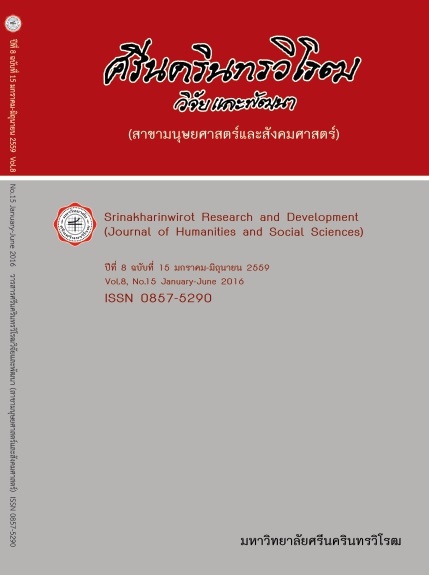ชุมชนเข้มแข็งสร้างกรุงเทพฯ ยั่งยืน: ตัวชี้วัดและบทเรียนความสำเร็จของชุมชน STRONG COMMUNITIES FOR CREATING COMMUNITIES SUSTAINABLITY IN BANGKOK METROPOLITAN : SUCCESS INDICATORS AND LESSONS IN COMMUNITY
Keywords:
ชุมชน ตัวชี้วัด บทเรียน ความสำเร็จAbstract
บทคัดย่อ
การวิจัยนี้มีวัตถุประสงค์ คือ 1) เพื่อพัฒนาตัวชี้วัดการคัดเลือกชุมชนในกรุงเทพมหานครโดยใช้กระบวนการมีส่วนร่วม ของภาคชุมชน ภาควิชาการ และภาครัฐ และ 2) เพื่อสังเคราะห์องค์ความรู้ของการพัฒนาชุมชนตัวอย่างในกรุงเทพมหานครที่ผ่านการคัดเลือกโดยใช้แนวคิดเชิงระบบ (System Approach)
ซึ่ง กลุ่มตัวอย่างที่ใช้ในการวิจัยครั้งนี้ คือ ชุมชนในกรุงเทพมหานครที่เข้าร่วมโครงการแผนชุมชนพึ่งตนเองตามแนวปรัชญาเศรษฐกิจพอเพียงของกรุงเทพมหานครที่ผ่านการคัดเลือก จำนวน 30 ชุมชนตัวอย่าง เครื่องมือ
ที่ใช้ในการเก็บรวบรวมข้อมูลครั้งนี้ คือ แบบสัมภาษณ์ และแบบสอบถาม ผลการวิจัย พบว่า
- ตัวชี้วัดการคัดเลือกชุมชนในกรุงเทพมหานคร มี 4 องค์ประกอบ 9 ตัวชี้วัดหลัก ตามแนวคิดการ
ประเมินผล CIPP พบว่า องค์ประกอบด้านบริบท (context) มี 1 ตัวชี้วัด คือ ชุมชนมีภาคีร่วมพัฒนา องค์ประกอบด้านปัจจัยนำเข้า (input) มี 2 ตัวชี้วัด คือ 1) มีผู้นำที่ได้รับการยอมรับและมีการสร้างผู้นำ 2) การจัดทำวิสัยทัศน์และกำหนดทิศทางการพัฒนาชุมชนอย่างเป็นระบบ ส่วนองค์ประกอบด้านกระบวนการ (process) มี 3 ตัวชี้วัด คือ 1) การมีส่วนร่วมของคนในชุมชน 2) การมีธรรมาภิบาลในชุมชน 3) มีการสำรวจข้อมูลชุมชน (ทรัพยากร / ทุนชุมชน) และองค์ประกอบด้านผลผลิต (product) มี 3 ตัวชี้วัด คือ 1) ชุมชนมีการศึกษาเรียนรู้ 2) ชุมชนมีการเรียนรู้และน้อมนำปรัชญาเศรษฐกิจพอเพียงสู่ชีวิต และ 3) มีกิจกรรมการพัฒนาที่บ่งชี้ถึงความสามารถในการพึ่งตนเอง
- บทเรียนของชุมชนเข้มแข็งสร้างกรุงเทพฯ ยั่งยืน จำนวน 30 ชุมชน แยกตามชุมชนเมือง 12 ชุมชน คิดเป็นร้อยละ 40.00 ชุมชนแออัด 9 ชุมชน คิดเป็นร้อยละ 30.00 ชุมชนชานเมือง 5 ชุมชน คิดเป็นร้อยละ 16.67 และชุมชนหมู่บ้านจัดสรร 4 ชุมชน คิดเป็นร้อยละ 13.33 พบว่า ชุมชนเมือง ชุมชนแออัด ชุมชนชานเมือง และชุมชนหมู่บ้านจัดสรร มีบทเรียนความสำเร็จของชุมชนที่ไม่แตกต่างกัน คือ ผู้นำชุมชนมีความเข้มแข็ง
มีคุณธรรมจริยธรรม ทุ่มเท เสียสละ รวมทั้งการมีส่วนร่วมของคนในชุมชน การมีทีมงานที่เสียสละ ทุ่มเทการทำงานให้ชุมชน ซึ่งถือเป็นปัจจัยนำเข้า โดยมีกระบวนการบริหารจัดการชุมชนที่ต่างกันตามบริบทและปัญหา
ที่เกิดขึ้นในแต่ละชุมชน เพื่อให้เกิดผลผลิตต่อชุมชนคือการพัฒนาชุมชนทั้งในด้านการศึกษาเรียนรู้ และการดำเนินกิจกรรมต่างๆ เพื่อการพึ่งตนเอง
Abstract
The purposes of this research were as follows: 1) to develop indicators for the selection of communities in the Bangkok metropolitan area through the community participation processes, academia and the government sector and 2) to synthesize the body of knowledge in the development communities in the Bangkok metropolitan area with a system approach. The sample group in this research was 30 sample communities in the Bangkok metropolitan area, which participate in the program for self-reliant community plans in accordance with the theory of self-sufficient economy in Bangkok. The research instruments included interview forms and questionnaires.
The research findings were as follows:
1. The indicators for selection of communities in the Bangkok metropolitan area with CIPP model consisted of 4 components 9 main indicators, the details of each component were as follows: (1) the context component consisted of 1 indicator namely that the community has stakeholder to takes part in the development; (2) the input component consisted of 2 indicators namely 1) there are accepted leaders and have the process for established and 2) there is a systematic set-up of a vision and a determined direction for development of the community; (3) the process component consisted of 3 indicators namely 1) people in the community are involved, 2) there is a good governance of the community and 3) data from the community are surveyed (assets/capital of the community); and (4) the product component consisted of 3 indicators namely 1) the community is educated and had knowledge management , 2) the community is informed and applies the theory of self-sufficiency in life and 3) the community has activities for development which indicates abilities for self-reliance.
2. As for Lessons from strong communities for creating a sustainable in Bangkok, the 30 communities consisted of 12 urban communities (equivalent to 40.00 %), 9 dense communities (equivalent to 30.00 %), 5 suburban communities (equivalent to 16.67 %) and 4 housing development communities (equivalent to 13.33 %). It was found that in the urban communities, the dense communities, the suburban communities and the housing development communities, there are lessons regarding internal community administration, which do not differ, namely that input component are the leaders of the communities are strong, that there is a considerable degree of virtue, dedication and selflessness, that the people in the community are involved and that there are selfless teams dedicated to work for the community. There are administrative processes for the communities, which differ according to the context and the problems appearing in the individual communities. The output of the community are people create production for the community, i.e. to develop the community in terms of education and in terms of various activities promoting self-reliance.Downloads
Downloads
Published
How to Cite
Issue
Section
License
Srinakharinwirot Research and Development Journal of Humanities and Social Sciences is licensed Under a Creative Commons Attribution-NonCommercial-NoDerivs 4.0 International (CC-BY-NC-ND 4.0) License, Unless Otherwise Stated. Please Read Journal Policies Page for More Information on Open Access, Copyright and Permissions.


